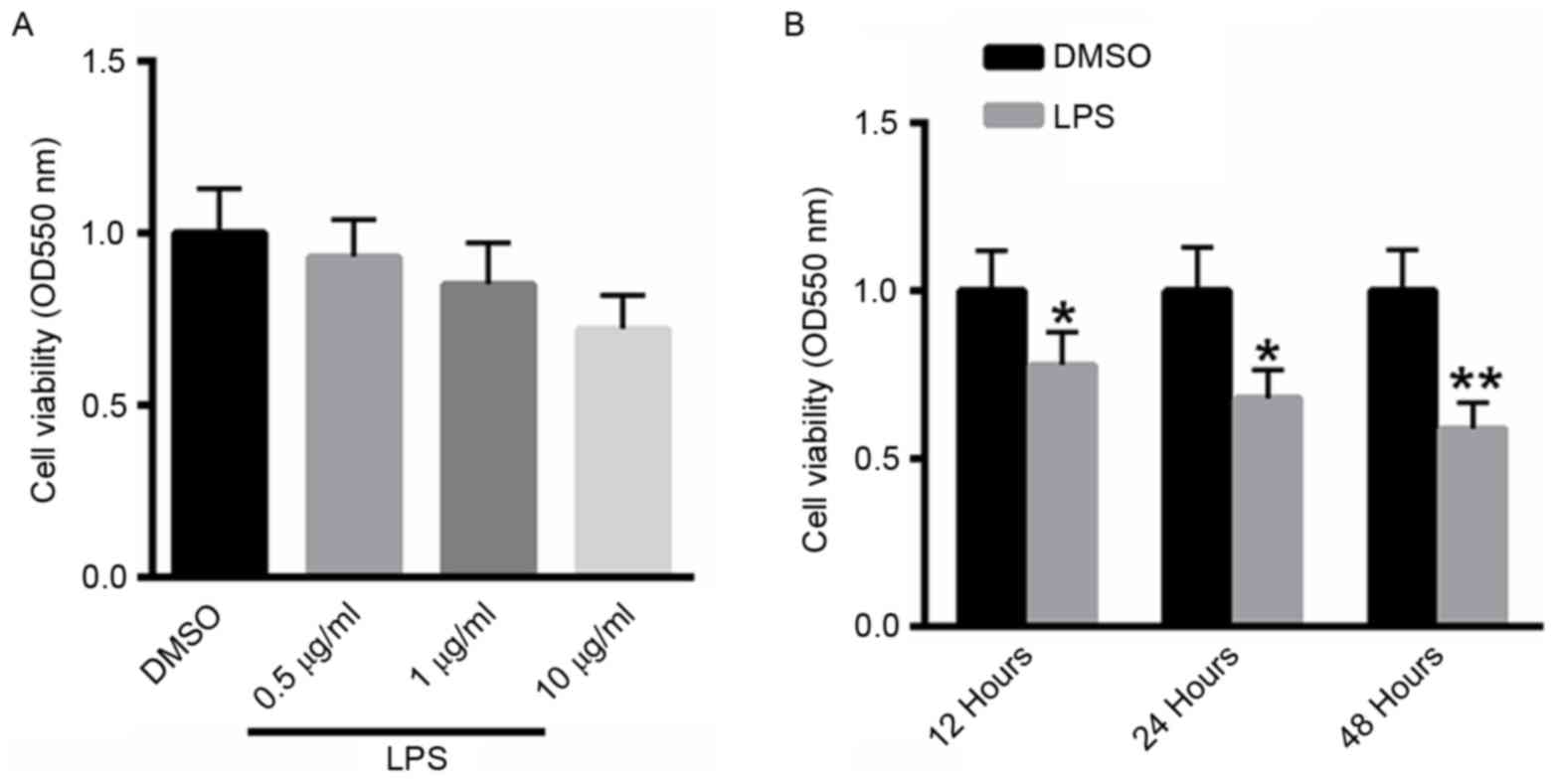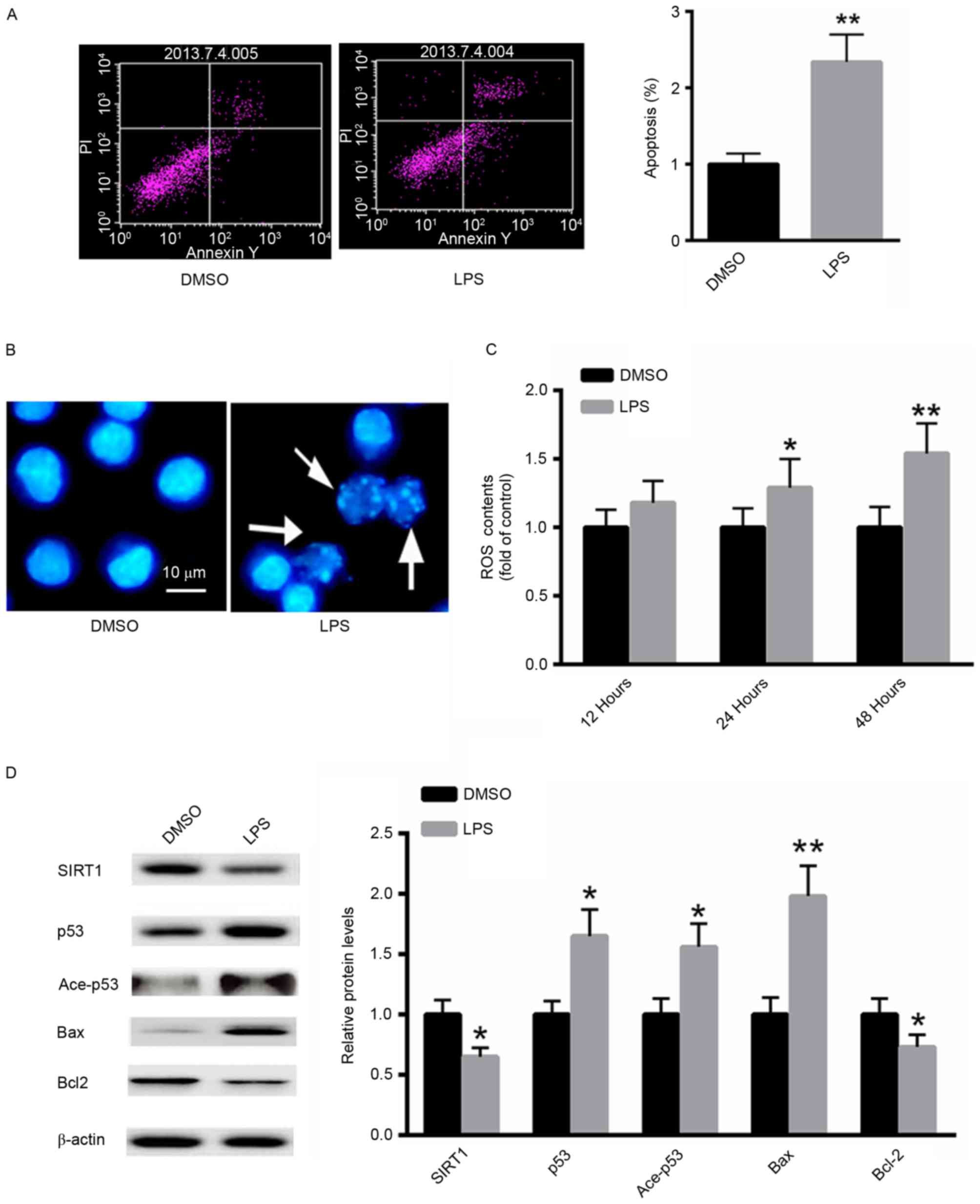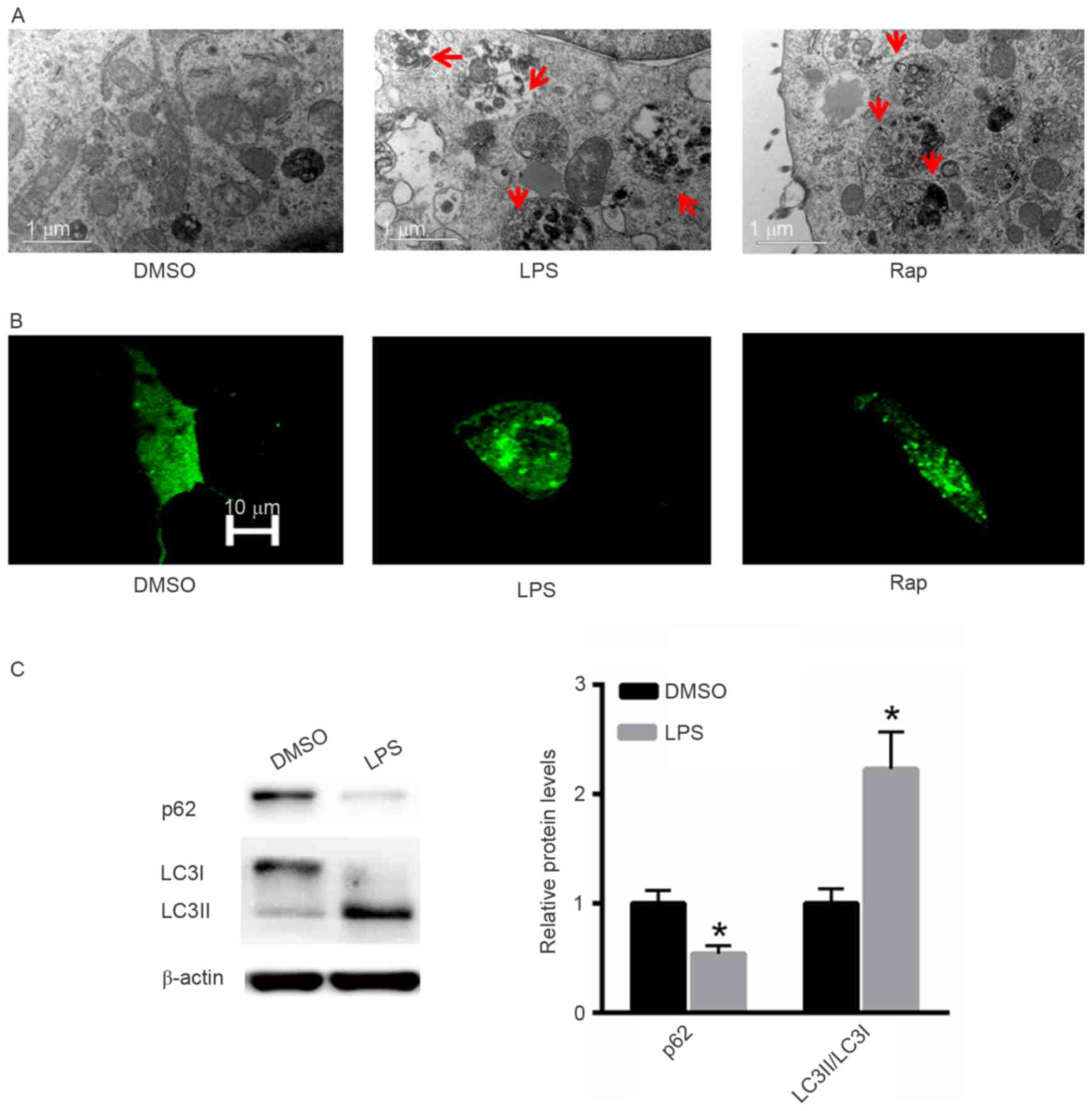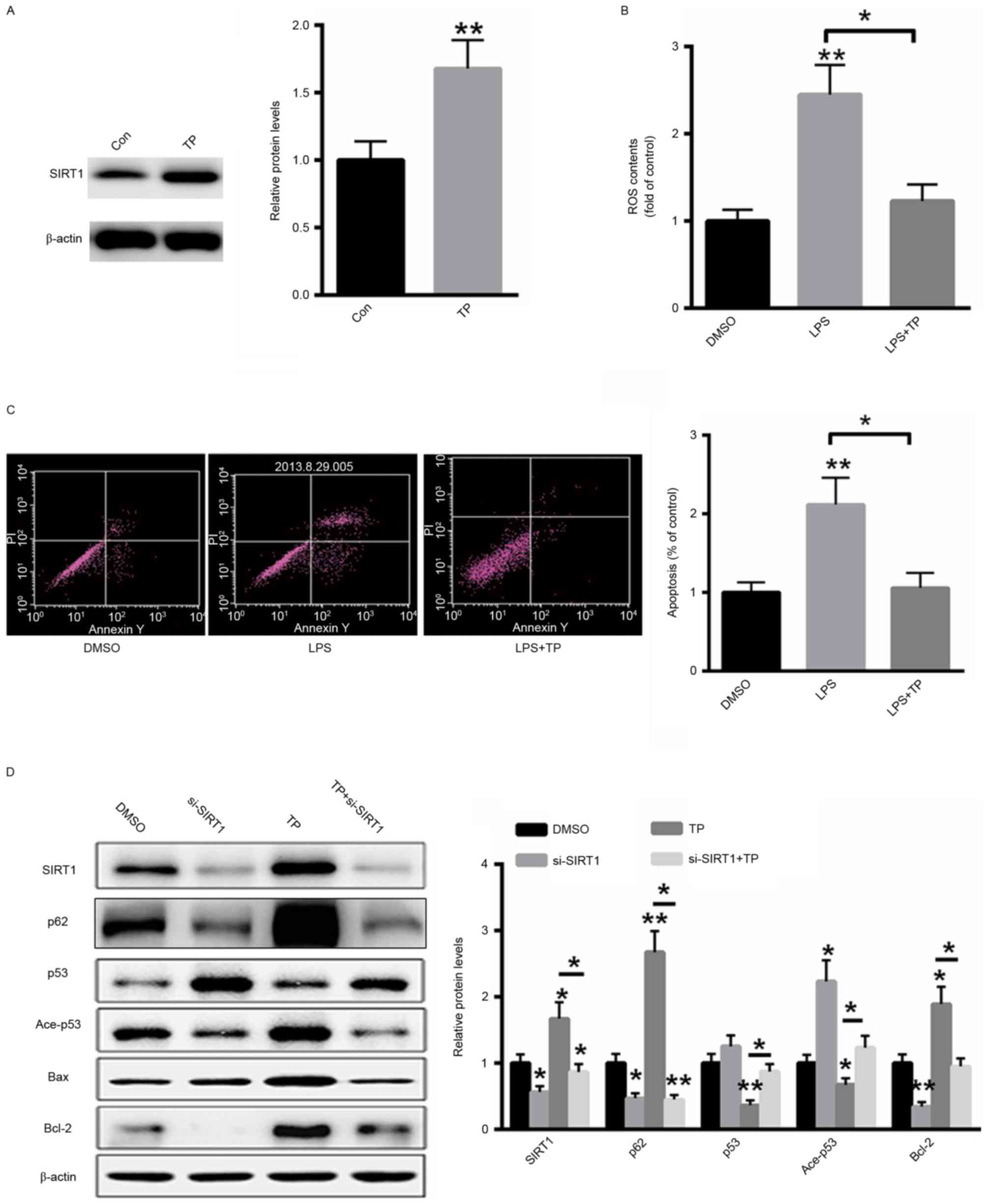Tremella polysaccharides inhibit cellular apoptosis and autophagy induced by Pseudomonas aeruginosa lipopolysaccharide in A549 cells through sirtuin 1 activation
Retraction in: /10.3892/ol.2024.14384
- Authors:
- Published online on: April 23, 2018 https://doi.org/10.3892/ol.2018.8554
- Pages: 9609-9616
-
Copyright: © Shi et al. This is an open access article distributed under the terms of Creative Commons Attribution License [CC BY_NC 4.0].
Abstract
Introduction
Pseudomonas aeruginosa is a prevalent opportunistic and virulent pathogen in pediatric patients (1,2). It is a common Gram-negative bacterium, which produces a variety of virulence factors, including exotoxins and enzymes. The major virulence factor of P. aeruginosa is lipopolysaccharide (LPS) (3,4). LPS is a major cause of respiratory tract disease in infants and young children worldwide. Therefore, it is crucial to develop effective preventative measures for LPS infection in pediatric patients. It has been demonstrated that LPS induces apoptotic cell death and intracellular reactive oxygen species (ROS) generation (5,6). ROS generation induces oxidative stress-mediated apoptotic cell death (7,8). Sirtuin 1 (SIRT1) is a nicotinamide-adenine dinucleotide-dependent class III protein deacetylase that belongs to the silent information regulator 2 gene family (7–10). SIRT1 has been associated with several physiological processes, including cellular apoptosis, autophagy, endocrine signaling, metabolism and chromatin remodeling (9–11). Tremella polysaccharides (TP) are isolated from the fruiting bodies and silver cell spore fermentation in Tremella fungi (12). Several biological actions have been attributed to TP, including cytokine-stimulation, anti-inflammatory and anti-diabetic activities (13,14). In a murine model, treatment with TP suppressed cancer cell DNA synthesis and growth (15). However, little is known about the anti-inflammatory role of TP in LPS infection in lung cancer.
In the present study, the role of TP in LPS-induced apoptosis and autophagy in A549 lung cancer cells was investigated. It was demonstrated that LPS suppresses SIRT1 protein expression, whereas treatment with TP increases SIRT1 expression and subsequently inhibits LPS-induced apoptosis and autophagy in A549 lung cancer cells.
Materials and methods
Cell culture and treatments
A549 lung cancer cells (American Type Culture Collection, Manassas, VA, USA) were maintained in DMEM/F-12 (HyClone; GE Healthcare Life Sciences, Logan, UT, USA), supplemented with 10% heat-inactivated fetal bovine serum (HyClone; GE Healthcare Life Sciences) and 100 U/ml penicillin and streptomycin. Cells were grown in 25 cm2 culture flasks at 37°C in a humidified atmosphere containing 5% CO2. LPS (Sigma-Aldrich; Merck KGaA, Darmstadt, Germany) was dissolved in PBS. Pretreatment with 10 µg/ml TP [dissolved in dimethyl sulfoxide (DMSO)] (Sigma-Aldrich; Merck KGaA) lasted for 48 h, and then there was an interval of 1 h prior to LPS treatment.
Cell viability assay
Cell viability was determined using the colorimetric MTT assay (Sigma-Aldrich; Merck KGaA). Briefly, A549 cells were seeded in 96-well tissue culture plates at a density of 5×104 cells/well. After 24 h, cells were treated with 0.5, 1 or 10 µg/ml LPS for 48 h or 10 µg/ml LPS for 12, 24 or 48 h, and then cultured in fresh medium containing 0.5 mg/ml MTT for 4 h at 37°C. Subsequently, the formazan crystals that formed were dissolved in DMSO and the absorbance was determined at 550 nm.
Intracellular ROS quantification
A549 cells were seeded in 6-well tissue culture plates at a density of 1×105 cells/well. When they had reached 70–80% confluence, cells were cultured for 16 h in serum-free DMEM/F-12. Following treatment with 10 µg/ml LPS for 48 h at 37°C, cells were incubated with 1 mM dichlorodihydrofluorescein diacetate for 40 min at 37°C in the dark. Cells were harvested and re-suspended in PBS. The relative fluorescence intensity was determined using a flow cytometer a BD FACSCalibur system (BD Biosciences, Franklin Lakes, NJ, USA) and data was analyzed using the ModFit software version 4.1 (Verity Software House, Inc., Topsham, ME, USA).
Flow cytometric analysis
Cellular apoptosis was determined using the Annexin V-Fluorescein Isothiocyanate (FITC) Apoptosis Detection kit (BD Biosciences), according to the manufacturer's protocol. Following treatment with 10 µg/ml LPS for 48 h at 37°C, cells were collected in a 5 ml culture tube and washed twice with ice-cold PBS. Cells were subsequently re-suspended in binding buffer and transferred to a new 5 ml culture tube. Annexin V-FITC (5 µl) and propidium iodide (5 µl) were added, and cells were incubated at room temperature for 15 min in the dark. Finally, 400 µl binding buffer was added and apoptotic cells were analyzed using a FC500 flow cytometry instrument equipped with CXP 2.0 software (Beckman Coulter, Bethesda, MA, USA) within 1 h.
Hoechst 33258 staining
Following treatment with 10 µg/ml LPS for 48 h at 37°C, cells were washed with ice-cold PBS three times and then fixed with 4% formaldehyde in PBS for 15 min (37°C). Subsequently, cells were stained with Hoechst 33258 (10 µg/ml) at 37°C for 5 min and washed three times with PBS. Finally, cells were observed under a fluorescent microscope (Olympus Corporation, Tokyo, Japan; magnification, ×40).
Western blotting
Total protein was extracted from cells using radioimmunoprecipitation assay buffer (Beijing Solarbio Science & Technology Co., Ltd., Beijing, China), according to the manufacturer's protocol. A bicinchoninic protein assay kit (Pierce; Thermo Fisher Scientific, Inc.) was used to determine the protein concentration. Immunoblotting was performed as previously described (16). Primary antibodies against SIRT1 (cat. no., 9475; dilution, 1:1,000), p62 (cat. no., 23214; dilution, 1:1,000), acetyl-p53 (cat. no., 2570; dilution, 1:1,000), p53 (cat. no., 2524; dilution, 1:1,000), B-cell lymphoma 2 (Bcl-2)-associated X protein (Bax; cat. no., 5023; dilution, 1:1,000), Bcl-2 (cat. no., 2872; dilution, 1:1,000), and β-actin (cat. no., 4970; dilution, 1:4,000) were obtained from Cell Signaling Technology, Inc. (Danvers, MA, USA). These antibodies were incubated with the membranes at 4°C overnight. Following three washes (10 min/wash) with TBST, the membranes were incubated with horseradish peroxidase-conjugated goat anti-rabbit IgG (1:5,000; cat. no., ZB-2306; Zhongshan Golden Bridge Biological Technology Co., Beijing, China) for 2 h at room temperature, and then washed three times (10 min/wash). The proteins were detected using enhanced chemiluminescence, according to the manufacturer's protocol (Merck KGaA, Darmstadt, Germany). ImageJ 1.8.0 (National Institutes of Health, Bethesda, MD, USA) was applied to quantify the relative protein levels. β-actin was used as an internal control.
Transient transfection of green fluorescent protein-microtubule-associated protein 1A/1B-light chain 3 (GFP-LC3)-expressing plasmid
A549 cells were seeded at a density of 5×105 cells/well in 6-well plates for 24 h. Transfection of a GFP-LC3-expressing plasmid (cat. no. 17-10230; Merck KGaA, Darmstadt, Germany) was performed using Lipofectamine 2000 reagent (Invitrogen; Thermo Fisher Scientific, Inc., Waltham, MA, USA), according to the manufacturer's protocol. After 24 h, cells were treated with 10 µg/ml LPS or 10 ng/ml rapamycin (Rap; R8718, Sigma-Aldrich; Merck KGaA) for 48 h at 37°C, and incubated for 16 h. GFP-LC3-positive cells were observed using a confocal laser microscope (LSM700; Carl Zeiss AG, Oberkochen, Germany).
Electron microscopy
Samples were fixed with 2% glutaraldehyde-paraformaldehyde in 0.1 M phosphate buffer, pH 7.4, for 12 h at 4°C and washed three times for 30 min with 0.1 M phosphate buffer. Subsequently, samples were incubated with 1% OsO4 dissolved in 0.1 M phosphate buffer for 2 h, dehydrated in an ascending ethanol series (50–100%) and infiltrated with propylene oxide. The Poly/Bed® 812 kit (Polysciences, Inc., Warrington, PA, USA) was used for resin embedding and polymerization was performed at 60°C in an electron microscope oven (TD-700; DOSAKA, Kyoto, Japan) for 24 h according to the manufacturer's protocol. Sections 350 nm in size were cut and stained using toluidine blue for 20 min at room temperature (for light microscopy) and 70 nm thin sections were double-stained using 7% uranyl acetate and lead citrate for 20 min at room temperature. Sections were cut using a Leica Ultracut UCT Ultra-microtome (Leica Microsystems GmbH, Wetzlar, Germany) and observed using a transmission electron microscope (JEM-1011; JEOL, Ltd., Tokyo, Japan) at an acceleration voltage of 80 kV.
Transient transfection
Cells were transfected with small interfering RNA (siRNA) targeting si-SIRT1 (12241, Cell Signaling Technology, Inc., Danvers, MA, USA), or with negative control siRNA (NC; 5′-ACUAGUCGAUCUAUGUGUGAUATT-3′) (Shanghai GenePharma Co., Ltd., Shanghai, China) using Lipofectamine® 2000 (Invitrogen; Thermo Fisher Scientific, Inc.) at the final concentration of 20 nM, according to the manufacturer's protocol. In brief, A549 cells (1×106 cells/well) were seeded in a 6-well plate with 2 ml RPMI-1640 medium (HyClone; GE Healthcare Life Sciences). At 60% confluence, si-SIRT1 or NC was mixed with Lipofectamine® 2000 (Invitrogen; Thermo Fisher Scientific, Inc.) at room temperature for 20 min. Then, the mixture was added into each well at a final concentration of 20 nM for 48 h. Then, the cells were collected for further analysis.
Statistical analysis
Data are expressed as the mean ± standard error of the mean. Multiple comparisons were evaluated by analysis of variance followed by Tukey's multiple-comparison test. P<0.05 was considered to indicate a statistically significant difference.
Results
LPS inhibits the viability of A549 cells in a time- and dose-dependent manner
A549 cells were treated with 0.5, 1 or 10 µg/ml LPS for 48 h, and cell viability was determined using the MTT assay. As presented in Fig. 1A, treatment with LPS suppressed the viability of A549 cells in a dose-dependent manner. A549 cells were also treated with 10 µg/ml LPS for 12, 24, 48 h. Notably, treatment with LPS inhibited the viability of A529 cells in a dose-dependent manner (Fig. 1B).
LPS induces apoptosis in A549 cells
The effect of LPS treatment on the induction of apoptosis in A549 cells was investigated using flow cytometric analysis. LPS significantly increased the proportion of A549 apoptotic cells ~2.3-fold compared with the untreated control (Fig. 2A). Furthermore, Hoechst 33258 staining demonstrated increased numbers of apoptotic cells following treatment with LPS (Fig. 2B). ROS generation following LPS treatment was also examined. As presented in Fig. 2C, treatment with LPS significantly increased ROS generation in A549 cells in a time-dependent manner. Western blot analysis demonstrated that LPS treatment markedly decreased the protein level of SIRT1, whereas the acetylated and total p53 protein expression were increased. Additionally, the expression of the pro-apoptotic protein Bax was significantly induced, whereas the expression of Bcl-2 was suppressed (Fig. 2D). These results suggest that LPS treatment induces a pro-apoptotic effect in A549 cells.
LPS induces autophagy in A549 cells
The effect of LPS treatment on the induction of autophagy was also investigated. Rap was used as a positive control. Electron microscopy demonstrated that LPS induced autophagy in A549 cells in a similar pattern to that induced by Rap (Fig. 3A). Following GFP-LC3 transfection increased numbers of autophagic vesicles (autophagosomes) were observed in A549 cells treated with LPS or Rap (Fig. 3B). Western blot analysis indicated that treatment with LPS significantly decreased p62 protein expression and increased the LC3II/LC3I ratio (Fig. 3C).
TP inhibits the LPS-induced apoptosis and autophagy in A549 cells by increasing SIRT1 protein expression
A549 cells were treated with 10 µg/ml TP for 48 h and total protein was extracted from cells. As presented in Fig. 4A, treatment with TP significantly increased the protein expression of SIRT1. ROS generation following LPS treatment with or without 10 µg/ml TP was also examined. TP treatment significantly decreased ROS generation in LPS-treated A549 cells (Fig. 4B). Furthermore, the effect of TP on the induction of apoptosis in A549 cells treated with LPS was also investigated and it was demonstrated that treatment with TP reversed the LPS-induced apoptosis (Fig. 4C). Additionally, western blot analysis demonstrated that transfection with a small interfering RNA targeting SIRT1 inhibited the expression of SIRT1 even in the presence of TP. Furthermore, the expression levels of acetylated and total p53 were also reversed by TP treatment, whereas the protein expression of p62 and Bcl-2 was induced and the protein expression of Bax was suppressed. These results indicate that TP serves an anti-apoptotic role in A549 cells treated with LPS and that this effect is abolished by SIRT1 silencing (Fig. 4D).
Discussion
P. aeruginosa is associated with hospital-acquired infections frequently in pediatric patients (17,18). LPS is considered a major virulence factor of P. aeruginosa (19,20). LPS infection in pediatric patients may lead to the self-limited upper respiratory tract infection or may develop into severe lower respiratory tract disease often associated with airflow obstruction and high mortality among children. Therefore, the research of therapeutic improvement of this infection is of great importance.
In the present study, it was initially demonstrated that LPS inhibited the viability of A549 cells in a time- and dose-dependent manner. LPS infection appears to exert a deleterious effect on A549 cells, indicating a potential threat of lung injury. The effect of LPS treatment on the induction of apoptosis in A549 cells was also investigated and LPS was demonstrated to induce apoptosis in A549 cells. Previous studies have demonstrated that ROS generation serves a critical role in bacteria-associated cell death (21,22). Therefore, it was hypothesized that LPS-induced apoptosis may be associated with ROS generation. It was demonstrated that LPS increased ROS generation in a time-dependent manner, suggesting that increased ROS production serves a crucial role in the apoptotic cell death induced by P. aeruginosa infection.
It has been demonstrated that SIRT1 serves a key role in several cellular functions, including cell survival, stress resistance and apoptosis (10,23). p53 is a well-characterized SIRT1 substrate (24). It has been reported that SIRT1 deacetylates p53 and decreases the expression of downstream genes, including Bax (24). However, very little is known about the association between SIRT1 and P. aeruginosa infection. The aim of the present study was to evaluate the role of SIRT1 in LPS-induced apoptosis in A549 cells. The results of the present study demonstrated that LPS treatment decreased the protein expression of SIRT1 in A549 cells and indicated that suppressed SIRT1 expression may be associated with LPS-induced lung injury.
Several pharmacological activities, including anti-diabetic and anti-inflammatory action, have been attributed to TP (25–27). However, to the best of our knowledge, the role of TP in the prevention of LPS-induced lung injury has not been investigated to date. The results of the present study demonstrated that treatment with TP inhibited LPS-induced apoptotic cell death in A549 cells. Furthermore, ROS generation induced by LPS was significantly decreased following TP treatment of A549 cells, suggesting a protective role of TP in lung injury. The expression of SIRT1 following TP treatment was also investigated, and it was demonstrated that TP activates SIRT1 expression leading to decreased acetylation of p53, decreased Bax expression and subsequently inhibiting LPS-induced apoptosis.
Autophagy has a dual role in the regulation of cell death. In certain situations, it serves a protective role against harmful conditions promoting cell survival or it may induce programmed cell death, termed autophagic cell death (28,29). Previous studies investigated the association between autophagy and apoptosis (30,31). A number of drugs are known to activate apoptotic and autophagic pathways. For instance, ceramide has been described to induce apoptosis and autophagy in breast and colon cancer cell lines, respectively (32). The antibacterial drug chloroquine chloride has been demonstrated to induce autophagy and apoptotic cell death in leukemia and myeloma cells by inhibiting the mammalian target of rapamycin signaling pathway (33). In the present study, the effect of TP on the induction of autophagy in A549 cells was investigated. It was demonstrated that LPS induced autophagy, which was inhibited by treatment with TP. Notably, this effect could be reversed by knockdown of SIRT1 in A549 cells.
The results of the present study demonstrated that TP induces the expression of SIRT1 and inhibits the LPS-induced ROS generation, autophagy and apoptotic cell death in A549 cells. The results of the present study may have important clinical implications for the treatment of LPS-associated disease in patients with lung injury.
Acknowledgements
Not applicable.
Funding
This study was supported by grants (grant no. 81700634) from National Natural Science Foundation of China.
Availability of data and materials
The datasets used and/or analyzed during the current study are available from the corresponding author on reasonable request.
Authors' contributions
XS performed the experiments and analyzed the data. WW performed part of the animal experiments. NW designed the experiments, analyzed the data and gave final approval of the final version to be published.
Ethics approval and consent to participate
Not applicable.
Consent for publication
Not applicable.
Competing interests
The authors declare that they have no competing interests.
References
|
Van Oosten B and Harroun TA: A MARTINI extension for Pseudomonas aeruginosa PAO1 lipopolysaccharide. J Mol Graph Model. 63:125–133. 2016. View Article : Google Scholar : PubMed/NCBI | |
|
Alshalchi SA and Anderson GG: Expression of the lipopolysaccharide biosynthesis gene lpxD affects biofilm formation of Pseudomonas aeruginosa. Arch Microbiol. 197:135–145. 2015. View Article : Google Scholar : PubMed/NCBI | |
|
Bollati M, Villa R, Gourlay LJ, Benedet M, Dehò G, Polissi A, Barbiroli A, Martorana AM, Sperandeo P, Bolognesi M and Nardini M: Crystal structure of LptH, the periplasmic component of the lipopolysaccharide transport machinery from Pseudomonas aeruginosa. FEBS J. 282:1980–1997. 2015. View Article : Google Scholar : PubMed/NCBI | |
|
Hao Y, Murphy K, Lo RY, Khursigara CM and Lam JS: Single-nucleotide polymorphisms found in the migA and wbpX Glycosyltransferase genes account for the intrinsic lipopolysaccharide defects exhibited by pseudomonas aeruginosa PA14. J Bacteriol. 197:2780–2791. 2015. View Article : Google Scholar : PubMed/NCBI | |
|
Ruhal R, Antti H, Rzhepishevska O, Boulanger N, Barbero DR, Wai SN, Uhlin BE and Ramstedt M: A multivariate approach to correlate bacterial surface properties to biofilm formation by lipopolysaccharide mutants of Pseudomonas aeruginosa. Colloids Surf B Biointerfaces. 127:182–191. 2015. View Article : Google Scholar : PubMed/NCBI | |
|
Sardar RK, Kavita K and Jha B: Lipopolysaccharide of Marinobacter litoralis inhibits swarming motility and biofilm formation in Pseudomonas aeruginosa PA01. Carbohydr Polym. 123:468–475. 2015. View Article : Google Scholar : PubMed/NCBI | |
|
Li Z, Qin B, Qi X, Mao J and Wu D: Isoalantolactone induces apoptosis in human breast cancer cells via ROS-mediated mitochondrial pathway and downregulation of SIRT1. Arch Pharm Res. 39:1441–1453. 2016. View Article : Google Scholar : PubMed/NCBI | |
|
Suzuki M, Bandoski C and Bartlett JD: Fluoride induces oxidative damage and SIRT1/autophagy through ROS-mediated JNK signaling. Free Radic Biol Med. 89:369–378. 2015. View Article : Google Scholar : PubMed/NCBI | |
|
Wang T, Gu J, Wu PF, Wang F, Xiong Z, Yang YJ, Wu WN, Dong LD and Chen JG: Protection by tetrahydroxystilbene glucoside against cerebral ischemia: Involvement of JNK, SIRT1 and NF-kappaB pathways and inhibition of intracellular ROS/RNS generation. Free Radic Biol Med. 47:229–240. 2009. View Article : Google Scholar : PubMed/NCBI | |
|
Xie Y, Tu W, Zhang J, He M, Ye S, Dong C and Shao C: SirT1 knockdown potentiates radiation-induced bystander effect through promoting c-Myc activity and thus facilitating ROS accumulation. Mutat Res. 772:23–29. 2015. View Article : Google Scholar : PubMed/NCBI | |
|
Yang LJ, Chen Y, He J, Yi S, Wen L, Zhao S and Cui GH: Effects of gambogic acid on the activation of caspase-3 and downregulation of SIRT1 in RPMI-8226 multiple myeloma cells via the accumulation of ROS. Oncol Lett. 3:1159–1165. 2012. View Article : Google Scholar : PubMed/NCBI | |
|
Zhou Y, Chen X, Yi R, Li G, Sun P, Qian Y and Zhao X: Immunomodulatory effect of tremella polysaccharides against cyclophosphamide-induced immunosuppression in mice. Molecules. 23:E2392018. View Article : Google Scholar : PubMed/NCBI | |
|
Du XJ, Zhang JS, Yang Y, Tang QJ, Jia W and Pan YJ: Purification, chemical modification and immunostimulating activity of polysaccharides from Tremella aurantialba fruit bodies. J Zhejiang Univ Sci B. 11:437–442. 2010. View Article : Google Scholar : PubMed/NCBI | |
|
Khondka P: Composition and partial structure characterization of tremella polysaccharides. Mycobiology. 37:286–294. 2009. View Article : Google Scholar : PubMed/NCBI | |
|
Jin Y, Hu X, Zhang Y and Liu T: Studies on the purification of polysaccharides separated from Tremella fuciformis and their neuroprotective effect. Mol Med Rep. 13:3985–3992. 2016. View Article : Google Scholar : PubMed/NCBI | |
|
Dong Y, Bao C, Yu J and Liu X: Receptor-interacting protein kinase 3-mediated programmed cell necrosis in rats subjected to focal cerebral ischemia-reperfusion injury. Mol Med Rep. 14:728–736. 2016. View Article : Google Scholar : PubMed/NCBI | |
|
Biedenbach DJ, Giao PT, Van Hung P, Su Minh Tuyet N, Thi Thanh Nga T, Phuong DM, Trung Vu N and Badal RE: Antimicrobial-resistant pseudomonas aeruginosa and acinetobacter baumannii from patients with hospital-acquired or ventilator-associated pneumonia in vietnam. Clin Ther. 38:2098–2105. 2016. View Article : Google Scholar : PubMed/NCBI | |
|
Li Y, Qu HP, Liu JL and Wan HY: Correlation between group behavior and quorum sensing in Pseudomonas aeruginosa isolated from patients with hospital-acquired pneumonia. J Thorac Dis. 6:810–817. 2014.PubMed/NCBI | |
|
Fujii A, Seki M, Higashiguchi M, Tachibana I, Kumanogoh A and Tomono K: Community-acquired, hospital-acquired and healthcare-associated pneumonia caused by Pseudomonas aeruginosa. Respir Med Case Rep. 12:30–33. 2014.PubMed/NCBI | |
|
Furtado GH, Gales AC, Perdiz LB, Santos AE, Wey SB and Medeiros EA: Risk factors for hospital-acquired pneumonia caused by imipenem-resistant Pseudomonas aeruginosa in an intensive care unit. Anaesth Intensive Care. 38:994–1001. 2010.PubMed/NCBI | |
|
Xu Y, Duan C, Kuang Z, Hao Y, Jeffries JL and Lau GW: Pseudomonas aeruginosa pyocyanin activates NRF2-ARE-mediated transcriptional response via the ROS-EGFR-PI3K-AKT/MEK-ERK MAP kinase signaling in pulmonary epithelial cells. PLoS One. 8:e725282013. View Article : Google Scholar : PubMed/NCBI | |
|
Yan F, Li W, Jono H, Li Q, Zhang S, Li JD and Shen H: Reactive oxygen species regulate Pseudomonas aeruginosa lipopolysaccharide-induced MUC5AC mucin expression via PKC-NADPH oxidase-ROS-TGF-alpha signaling pathways in human airway epithelial cells. Biochem Biophys Res Commun. 366:513–519. 2008. View Article : Google Scholar : PubMed/NCBI | |
|
Zeng R, Chen Y, Zhao S and Cui GH: Autophagy counteracts apoptosis in human multiple myeloma cells exposed to oridonin in vitro via regulating intracellular ROS and SIRT1. Acta Pharmacol Sin. 33:91–100. 2012. View Article : Google Scholar : PubMed/NCBI | |
|
Vaziri H, Dessain SK, Eaton Ng E, Imai SI, Frye RA, Pandita TK, Guarente L and Weinberg RA: hSIR2 (SIRT1) functions as an NAD-dependent p53 deacetylase. Cell. 107:149–159. 2001. View Article : Google Scholar : PubMed/NCBI | |
|
Zhang ZC, Lian B, Huang DM and Cui FJ: Compare activities on regulating lipid-metabolism and reducing oxidative stress of diabetic rats of Tremella aurantialba broth's extract (TBE) with its mycelia polysaccharides (TMP). J Food Sci. 74:H15–H21. 2009. View Article : Google Scholar : PubMed/NCBI | |
|
Khondkar P, Aidoo KE and Tester RF: Sugar profile of extracellular polysaccharides from different Tremella species. Int J Food Microbiol. 79:121–129. 2002. View Article : Google Scholar : PubMed/NCBI | |
|
Kiho T, Morimoto H, Sakushima M, Usui S and Ukai S: Polysaccharides in fungi. XXXV. Anti diabetic activity of an acidic polysaccharide from the fruiting bodies of Tremella aurantia. Biol Pharm Bull. 18:1627–1629. 1995. View Article : Google Scholar : PubMed/NCBI | |
|
Keta O, Bulat T, Golić I, Incerti S, Korać A, Petrović I and Ristić-Fira A: The impact of autophagy on cell death modalities in CRL-5876 lung adenocarcinoma cells after their exposure to gamma-rays and/or erlotinib. Cell Biol Toxicol. 32:83–101. 2016. View Article : Google Scholar : PubMed/NCBI | |
|
Ryter SW, Mizumura K and Choi AM: The impact of autophagy on cell death modalities. Int J Cell Biol. 2014:5026762014. View Article : Google Scholar : PubMed/NCBI | |
|
Gump JM and Thorburn A: Autophagy and apoptosis: What is the connection? Trends Cell Biol. 21:387–392. 2011. View Article : Google Scholar : PubMed/NCBI | |
|
Su M, Mei Y and Sinha S: Role of the crosstalk between autophagy and apoptosis in cancer. J Oncol. 2013:1027352013. View Article : Google Scholar : PubMed/NCBI | |
|
Pattingre S, Bauvy C, Carpentier S, Levade T, Levine B and Codogno P: Role of JNK1-dependent Bcl-2 phosphorylation in ceramide-induced macroautophagy. J Biol Chem. 284:2719–2728. 2009. View Article : Google Scholar : PubMed/NCBI | |
|
Cao B, Li J, Zhou X, Juan J, Han K, Zhang Z, Kong Y, Wang J and Mao X: Clioquinol induces pro-death autophagy in leukemia and myeloma cells by disrupting the mTOR signaling pathway. Sci Rep. 4:57492014. View Article : Google Scholar : PubMed/NCBI |













